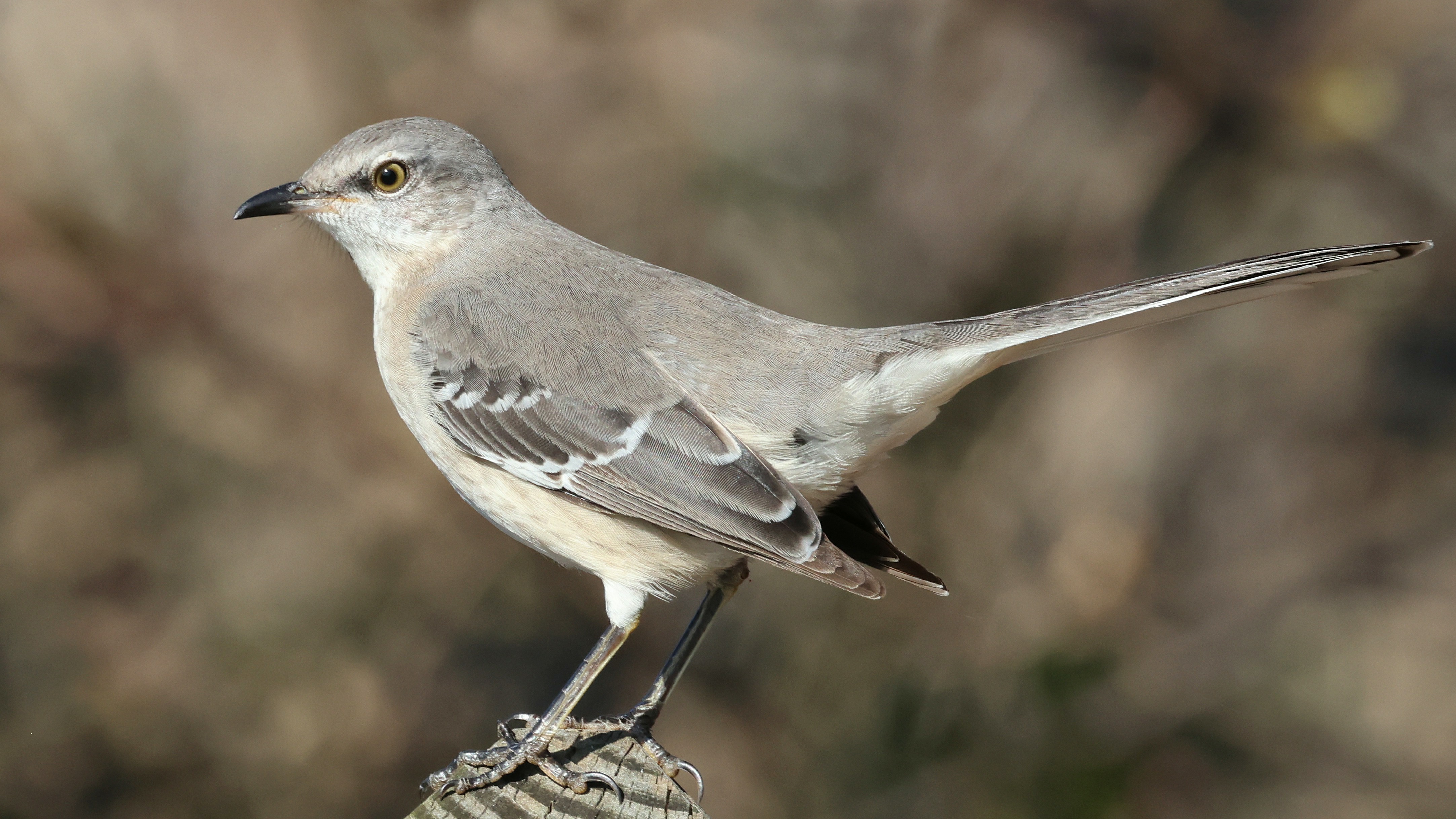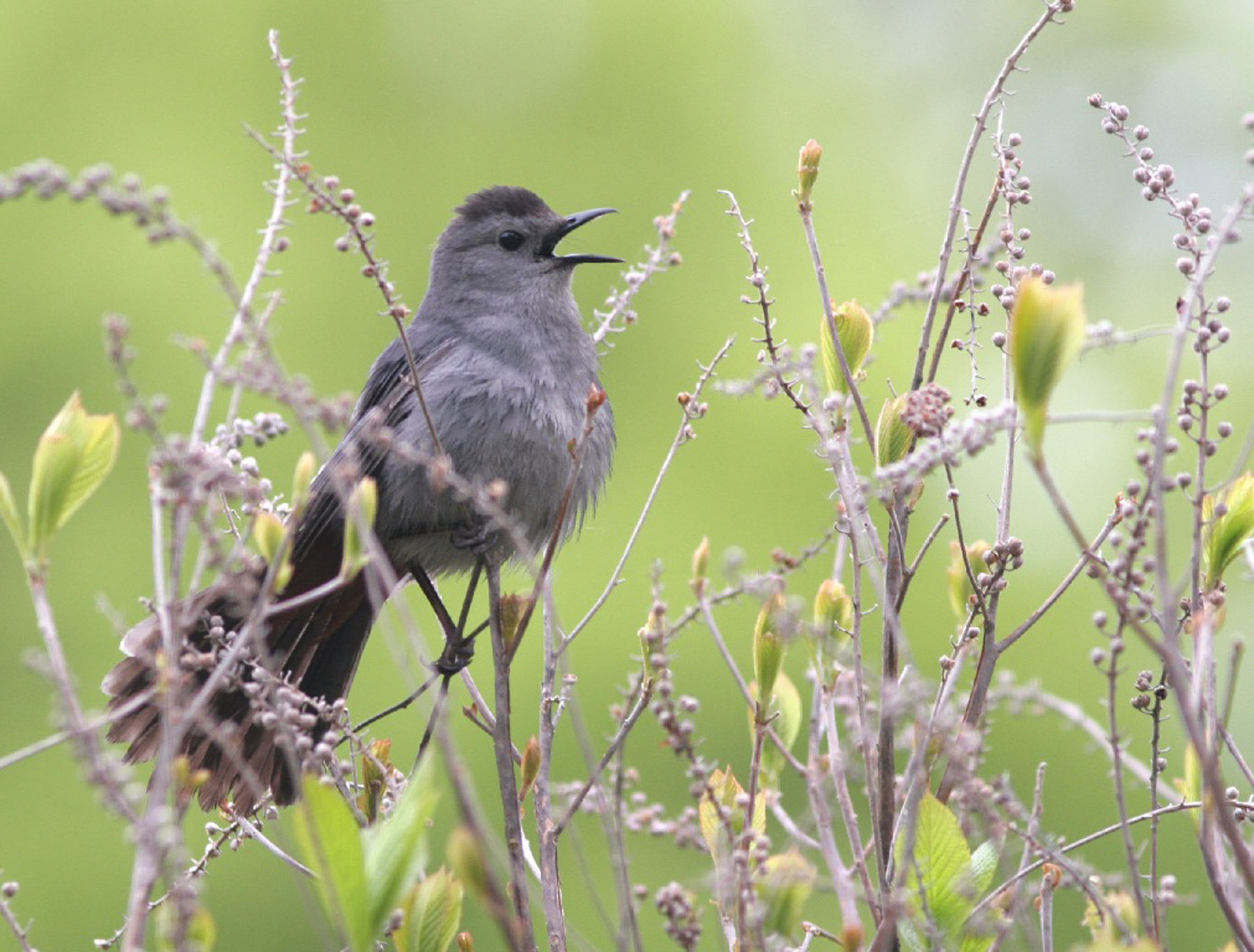
We’ve all heard of mockingbirds, but have you actually seen one in our area? Or heard one locally?
You’ll probably notice the insistent, varied, nonstop song of a northern mockingbird (Mimus polyglottos) before you see this medium-sized gray-brown bird. You’re likely to spot it perched on a conspicuous high spot on a wire, hedge top, or roof peak. Or you might realize that its song is coming from deep in a dense bush.
At first, you might think that various other birds are nearby, due to the different songs you hear, but true to their name, northern mockingbird are famous mimics. They include pieces of other birds’ songs in their own (listen: https://www.allaboutbirds.org/guide/Northern_Mockingbird/sounds). You might hear familiar bits from a cardinal, Carolina wren, tufted titmouse, blue jay, bluebird, or even a flicker or kingfisher. And that’s not all. Mockingbirds imitate other sounds, such as frog calls, insect sounds, and mechanical noises. Adult males can have up to 200 songs. Females also sing, though more quietly and more likely during the fall.
Northern mockingbirds are year-round residents in Massachusetts, but it hasn’t always been so. They are native to the South, where 5 states list them as their state bird: Arkansas, Florida, Mississippi, Tennessee, and Texas. If you’ve been to the South, you might have been awakened by a northern mockingbird. They often sing at night, and start hour before dawn. Here in New England, American robins (Turdus migratorius) are the birds that usually awaken us with song well before dawn in springtime.
How did mockingbirds get here? They expanded their range northward in the 1800s and were first recorded in Massachusetts in 1852. Here they found the kind of open country they like – farm fields and forest edges. They also adapted to living in towns and suburbs, especially as forests returned in the 1900s. From the 1970s on, they benefited from plantings that came with development, especially shrubs that produce berries and offer protected nesting sites. The warming climate in New England helped. So also did the spread of a particular berry-producing invasive shrub, multiflora rose (Rosa multiflora). Yet in the past two decades, northern mockingbird populations in Massachusetts appear to be declining.

What’s the point of northern mockingbirds’ long, elaborate songs and inventive mimicry? One point is to establish and defend territory. Here in New England, our resident mockingbirds usually establish two territories: a breeding territory in the spring, and a wintering territory in the fall. Male mockingbirds start to sing in spring – any time now! – to claim a breeding territory. It needs to include good nesting sites and good sources of insects (to feed as protein to growing chicks). Competing males may sing back and forth and even face off physically at a boundary.
Once a breeding territory is established, the male’s fancy songs have another point: to attract females. When a female enters the territory, courtship begins with the male chasing the female for a few days. The male also brings sticks to several possible nesting sites. The pair eventually makes a nest at one. The male builds a base of twigs and the female creates a soft inner grass lining. Both male and female can be aggressive in defending their nest from other mockingbirds, other species, and even pet cats and people who get too close. Mockingbirds in our area may raise a second brood in a new nest.
What about the mimicry? It’s part of impressing both rivals and females, but especially females. The longer and more varied the song, the more fit the male seems to the female. Mockingbird songs are learned. Fledglings and young males learn their initial songs by imitating nearby adult male singers. As time goes on, they improvise and add more and more sounds imitated from their surroundings. This mimicry is a quick and ongoing way of creating long and diverse songs. It may also show that the male is a smart, fast learner. Mockingbirds are known as life-long song learners, although some recent research questions this idea.
In the fall, our male and female mockingbirds set up wintering territories, either together or separately. These territories center on a tree or dense shrub that provides berries or fruit. At this time, both male and female sing to defend a chosen winter food source against other fruit-eating birds, including robins and European starlings (Sturnus vulgaris).
Mockingbirds have a reputation for intelligence, but is it true that they’re smart? Recent research (2019) shows that mockingbirds can recognize individual humans and remember how threatening – or not – each has been. (For fun, read this).
People have long referred to mockingbirds in songs, lore, and literature, going back to Native American tales. More recently, the mockingbird serves as a symbol of innocence in Harper Lee’s novel To Kill a Mockingbird (1960).
Northern mockingbirds aren’t the only mimics you might hear. Listen for gray catbirds (Dumetella carolinensis). They are more numerous than mockingbirds in our area and will soon be returning. Less common are brown thrashers (Toxostoma rufum). How can you tell these songs apart? One clue is the number of times in a row that each bird repeats phrases in its songs. Mockingbirds tend to repeat phrases three times or more (https://nas-national-prod.s3.amazonaws.com/mockingbirdvid_0.mp4). Brown thrashers usually repeat twice (https://www.allaboutbirds.org/guide/Brown_Thrasher/sounds). Catbirds normally don’t repeat. Their songs seem long jumbles of different sounds, with an occasional tell-tale “meow” (https://www.allaboutbirds.org/guide/Gray_Catbird/sounds).

Other local mimics include blue jays (Cyanocitta cristata), which imitate hawk cries. European starlings mimic whistled songs such as the killdeers’, as well as cell phones and car alarms. American crows can mimic humans, growls and car alarms.
Enjoy this season of spring birdsong. Listen and look for northern mockingbirds, as well as gray catbirds (https://westboroughlandtrust.org/nn/nn78), brown thrashers, American robins (https://westboroughlandtrust.org/nn/nn166 ), blue jays (https://westboroughlandtrust.org/nn/nn161), European starlings (https://westboroughlandtrust.org/nn/nn115). Find multiflora rose blossoms in June & berries in fall (https://westboroughlandtrust.org/nn/nn77).
For what else to expect in March, check out the articles listed in WCLT’s online monthly Nature Notes index:
https://westboroughlandtrust.org/nn/nnindex?order=month#March
Do you know that Westborough has 60 miles of trails, and WCLT has trail maps? The Westborough Community Land Trust (WCLT) preserves, protects, and promotes open space in Westborough (westboroughlandtrust.org and facebook.com/westboroughlandtrust).
















